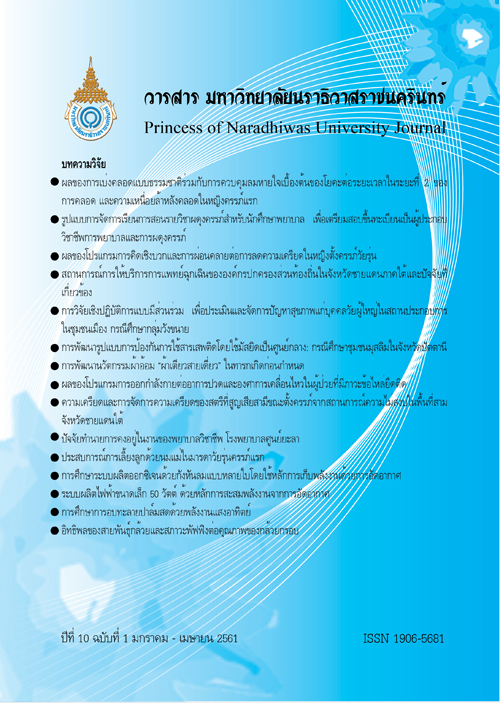Effects of Banana Variety and Puffing Conditions on Puffed Banana Qualities
Keywords:
Crisp banana, Banana variety, Puffing, Colour, TextureAbstract
The high temperature and short time technique (HTST) was applied to various banana varieties
for crisp banana producing. The HTST puffing suitable for producing of crisp banana because it can create
high porous structure and more crisp texture as compared with hot air dried product. However, no previous
literatures study the effect of banana variety on puffed product quality. Therefore, the objective of this
experiment was to study the effect of banana variety (Namwa-banana and Homtong-banana) and puffing
conditions (puffing temperature and puffing time) on puffed banana qualities i.e. colour, volume ratio and
texture property. The Namwa-banana slices with 21-23 oBrix and Homtong-banana with 16-18 oBrix of
total soluble solids were cut across into 2.5 min and it were blanched by 95 oC of hot water for 30 sec. After that, it were dried in 3 steps. First step, it were dried by hot air at temperature of 90 oC until its moisture
content reached 35% dry basis (d.b.). Then, the slices were puffed by hot air (130, 150 and 170 oC) for a
short duration (1.5, 2 and 2.5 min) in a laboratory HTST model. Final step, it were dried again by hot air at
temperature of 90 oC until its moisture content reached 4% d.b. The experimental results showed that the
banana variety affected on product quality. The puffed Namwa-banana had lower volume ratio and harder
texture than puffed Homtong-banana. However, the puffed Namwa-banana had better colour quality than
those puffed Homtong-banana. This is due to the Namwa-banana contains lower amount of monosaccharide
than those ones. The puffing conditions, puffing temperature and puffing time, strongly affected on
puffed banana quality. Increasing of puffing temperature together with longer puffing time provided higher
volume ratio and more crisp texture. However, the color of product in both of banana varieties had more
browning as higher puffing temperature and longer puffing time. To obtained a satistied puffed product,
the banana should be puffed under puffing temperature of 150 oC at least 2 min of puffing time.
References
Chemists.
Devahastin, S., Suvarnakuta, P., Soponronnarit, S. & Mujumdar, A.S. (2004). A comparative study of low-pressure superheated steam and vacuum drying of a heat-sensitive material. Drying Technology, 22, 1845-1867.
Hofsetz, K. & Lopes, C.C. (2005). Crispy banana obtained by the combination of a high temperature and short
time drying stage and a drying process. Brazilian Journal of Chemical Engineering, 22(2), 285-292.
Hofsetz, K., Lopez, C.C., Hubinger, M.D., Mayor, L. & Sereno, A.M. (2007). Change in the physical properties of bananas on applying HTST pulse during air drying. Journal of Food Engineering, 83(4), 531-540.
Im, J.S., Huff, H.E. & Hsieh, F.H. (2003). Effect of processing condition on the physical and chemical properties
of buckwheat grit cake. Journal of Agricultural and Food Chemistry, 51(3), 659-666.
Lefort, J.F., Durance, T.D. & Upadhyayal, M.K. (2003). Effect of tuber storage and cultivar on the quality of vacuum microwave dried potato chips. Journal of Food Science, 68, 690-696.
Maskan, M. (2001). Kinetics of colour change of kiwifriut during hot air and microwave drying. Journal of Food Engineering, 48, 169-175.
Mulla M.Z., Annapure U.S., Bharadwaj, V.R. & Singhal, R.S. (2016). A study on the kinetics of acrylamide formation in banana chips. Journal of Food Processing and Preservation, doi: 10.1111/jfpp.12739.
Mudahar, G.S., Toledo, R.T., Floros, J.D. & Jen, J.J. (1989). Optimization of carrot dehydration process using response surface methodology. Journal of Food Science, 54(3), 714 - 719.
Purlis, E. (2010). Browning development in bakery product. Journal of Food Engineering, 99, 169-175.
Raikham, C., Prachayawarakorn, S., Nathakaranakule, A. & Soponronnarit, S. (2013). Optimum conditions of fluidized bed puffing for producing crispy banana. Drying Technology, 31, 726-739.
Redgwell, R.J., Melton, L.D. & Brasch, D.J. (1992). Cell wall dissolution in ripening kiwifruit (Actinidia delicosa):
solubilisation of pectic polymers. Plant Physiology, 98, 71-81
Rocha, A.M.C.N. & Morais, A.M.M.B. (2003). Shelf life of minimally processed apple (cv. Jonagored) determined
by colour change. Food Control, 14, 13-20.
Saca, A.S. & Lozano, E.J. (1992). Explosion puffing of bananas. International Journal of Food Science and Technology, 27, 419-426.
Saeleaw, M. & Schleining, G. (2011). Effect of frying parameters on crispiness and sound emission of cassava
crackers. Journal of Food Engineering, 103, 229-236.
Tabtiang, S., Prachayawarakorn, S. & Soponronnarit, S. (2012). Effects of osmotic treatment and superheated
steam puffing temperature on drying characteristics and textural properties of banana slices. Drying Technology, 30, 20-28.
Tabtiang, S., Prachayawarakorn, S. & Soponronnarit, S. (2016). Optimum condition of producing crisp osmotic banana using superheated steam puffing. Journal of the Science of Food and Agriculture, 97, 1244-1251
Troncoso, E., Pedreschi, F. & Zúñiga, R.N. (2009). Comparative study of physical and sensory properties of pre-treated potato slices during vacuum and atmospheric frying. LWT-Food Science and Technology, 42, 187-195.
Varnalis, A.I., Brennan, J.G. & MacDougall, D.B. (2001). A proposed mechanism of high- temperature puffing of potato. Part I. the influence of blanching and drying conditions on the volume of puffed cubes. Journal of Food Engineering, 48, 361-367.




